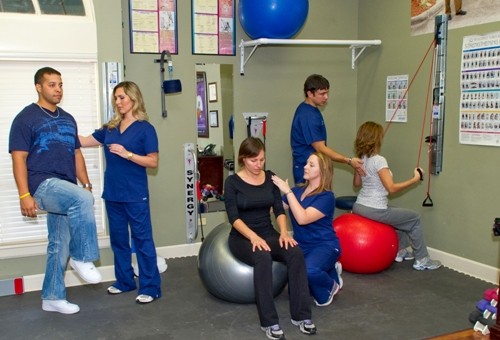Pinhook Chiropractic Clinic :: 337-237-2273
Tips on Stretching & Exercise
Stretching:
Stretching, because it relaxes your mind and tunes up your body, should be part of your daily life.
You will find that regular stretching will do the following:

Stretching, because it relaxes your mind and tunes up your body, should be part of your daily life.
You will find that regular stretching will do the following:
-
Increases range of motion
-
Helps maintain your current level of flexibility so as time passes you do not be come stiffer and stiffer
-
Helps prevent injuries, tight muscles, decreased joint function, and increased biomechanical stress such as muscle strains (A strong, flexible pre-stretched muscle resists better than a strong, stiff unstretched muscle.)
-
Reduces muscle tension and makes the body feel more relaxed
-
Feels good
-
Develops/Improves body awareness - As you stretch various parts of the body, you focus on them and get in touch with them - you get to know yourself.
WARNING! You can overstretch and tear muscle fibers if you aren't careful and/or don't listen to your body - use common sense. People with physical health problems especially with their joints should consult with a health care professional before starting a stretching program.
Who should stretch?
Everybody! You can improve your flexibility at any age.
Everyone can learn to stretch regardless of age or flexibility. You do not need to be in top physical condition or have specific athletic skills. Whether you sit at a desk all day, dig ditches, do housework, stand at an assembly line, drive a truck, or exercise regularly; the same techniques of stretching apply. The methods are gentle and easy, conforming to individual differences in muscle tension and flexibility. So, if you are healthy, without any specific physical problems, you can learn how to stretch safely and enjoyably.
When should you stretch?
Stretching can be done any time you feel like it: at work, in a car, waiting for a bus, walking down the road, under a nice shady tree after a hike or at the beach. Stretch before and after physical activity, but also stretch at various times of the day when you can.
Here are some examples:
-
In the morning before the start of the day
-
At work to release nervous tension
-
After sitting or standing for a long time
-
When you feel stiff
-
At odd times during the day, for instance when watching TV, listening to music, reading or sitting and talking
It's always a good idea to stretch before and after activities and if you feel stiff. Unfortunately, I have found that when I ask my patients to stretch 2-3 times a day, they soon get too busy and forget to stretch (especially when they're feeling better). Therefore, I now believe that stretching should be done on a spontaneous basis throughout the day. By spontaneous, I mean stretch while you are waiting for:
-
a bank teller
-
gas to fill
-
a meeting to start
-
a document to print
-
an elevator
-
anytime
How to stretch
Stretching should be done in a slow/gentle and painless manner. Where you "listen" to your body and stretch progressively over a 30-60 second period. Start with slight tension, without pain and increase stretch as the muscles relax.
Stretching should be done in a slow/gentle and painless manner. Where you "listen" to your body and stretch progressively over a 30-60 second period. Start with slight tension, without pain and increase stretch as the muscles relax.
Exercise
Exercise Therapy is a set of repetitive stretching or strengthening maneuvers designed to develop weakened or injured muscle groups that support the spine. Specific exercises help rehabilitate and stabilize the spine.
How does Exercise Therapy work?
The individual bones of the spine are held in place by muscles and ligaments. Proper motion and position of these bones are crucial for proper nervous system function, correct posture, and good health. Exercises and repeated maneuvers help these connective tissues.
Why is Exercise Therapy necessary?
By the time many patients seek professional help; fibrotic scar tissue has changed the elasticity and strength of supporting muscles. A program of carefully designed stretches and exercises helps restore better tone to these damaged tissues.
What can I expect from Exercise Therapy?
Results take time. Exercise Therapy is an inexpensive and effective way to speed your recovery, stabilize your spine, and help prevent a relapse.
Patient Benefits:
-
Increases range of motion
-
Retrains damaged muscles
-
Strengthens spinal structure
-
Speeds rehabilitation
-
Helps adjustments hold
Walking provides an excellent foundation for specific strengthening exercises.
We are committed to better health and serving you. Call us today at 337-237-2273.